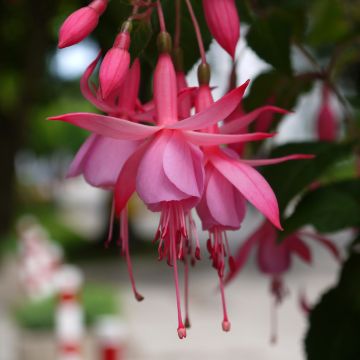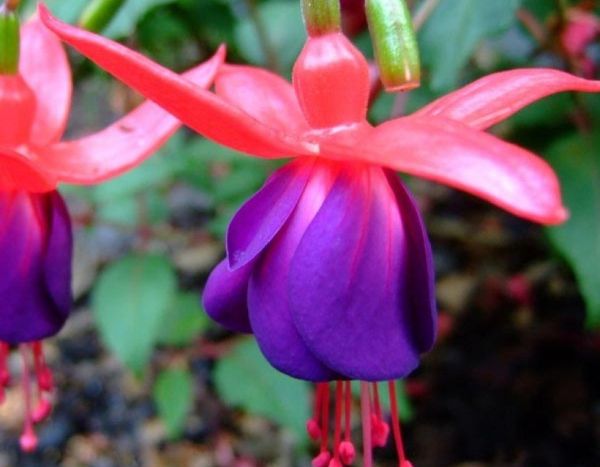

Epilobium canum Dublin
Epilobium canum Dublin
Epilobium canum subsp. angustifolium Dublin
California Fuchsia, Hummingbird Trumpet, Firechalice
Special offer!
Receive a €20 voucher for any order over €90 (excluding delivery costs, credit notes, and plastic-free options)!
1- Add your favorite plants to your cart.
2- Once you have reached €90, confirm your order (you can even choose the delivery date!).
3- As soon as your order is shipped, you will receive an email containing your voucher code, valid for 3 months (90 days).
Your voucher is unique and can only be used once, for any order with a minimum value of €20, excluding delivery costs.
Can be combined with other current offers, non-divisible and non-refundable.
Why not try an alternative variety in stock?
View all →This plant carries a 6 months recovery warranty
More information
We guarantee the quality of our plants for a full growing cycle, and will replace at our expense any plant that fails to recover under normal climatic and planting conditions.

Would this plant suit my garden?
Set up your Plantfit profile →
Description
Epilobium canum 'Dublin' is a low-growing selection of the California fuchsia with intense red flowering and beautiful velvety green-grey foliage. It is a perennial undershrub that spreads rapidly and blooms from summer to autumn, even in dry soils. This variety is adorned with numerous vibrant red tubular flowers similar to fuchsias. Its foliage disappears with all the stems in winter. Perfect for rock gardens or well-drained borders, it is one of the best perennials for dry gardens in not too cold climates.
The California fuchsia, formerly known as Zauschneria californica, surprisingly belongs to the onagraceae family, making it a cousin of evening primroses. This plant grows in the western United States on arid slopes and roams in the scrub vegetation in California and northwest Mexico, called chaparral.
Epilobium canum 'Dublin' is a horticultural selection that has been awarded in England for its ornamental qualities and ease of cultivation. This woody-based perennial forms a spreading and slightly tousled clump, 30 to 40 cm tall, spreading at least 50 to 60 cm. The remarkably long flowering period extends from July-August to October. With bright orange-red, 4 cm long flowers forming very wide tubes from which long stamens emerge. They are carried by a long swollen pedicel that will transform into a pod filled with numerous fine seeds. The foliage consists of small linear or sometimes ovate, opposite or alternate, velvety leaves, ranging in colour from green to greyish-green, depending on the climate and soil. When not in bloom, this fuchsia resembles a rosemary, without the fragrance. The plant completely disappears in winter in our climates, but is semi-evergreen in milder climates. This plant spreads slowly thanks to a strong suckering crown, occasionally becoming invasive if it is happy.
With its exuberant summer flowering, Epilobium canum 'Dublin' is a very good rock garden plant or border plant. It will also become indispensable in dry coastal gardens. On a dry slope, you can associate it with 'Pointe du Raz' rosemary, combining their blooms in October, in blue and red. In a rock garden, it accompanies tall sedums, rockroses, lavenders, 'Frejorgues' hairy dorycnium, or Helichrysum italicum. If you are interested in and like Zauschneria, don't miss the opportunity to try Hesperaloe parviflora, native to Mexico, a rhizomatous perennial with a fountain-like habit and spectacular coral-red summer inflorescences.
Flowering
Foliage
Plant habit
Botanical data
Epilobium
canum subsp. angustifolium
Dublin
Onagraceae
California Fuchsia, Hummingbird Trumpet, Firechalice
Zauschneria californica Glasnevin, Zauschneria californica Dublin
Cultivar or hybrid
Other Perennial Fuchsia
View all →Planting and care
Plant Epilobium canum 'Dublin' in any well-drained, light soil, even rocky and limestone, in full sun. Trim the flowers as they fade to prolong the flowering. Some watering in summer, during prolonged drought, promotes flowering.
Planting period
Intended location
Care
Planting & care advice
This item has not been reviewed yet - be the first to leave a review about it.
Similar products
Haven't found what you were looking for?
Hardiness is the lowest winter temperature a plant can endure without suffering serious damage or even dying. However, hardiness is affected by location (a sheltered area, such as a patio), protection (winter cover) and soil type (hardiness is improved by well-drained soil).

Photo Sharing Terms & Conditions
In order to encourage gardeners to interact and share their experiences, Promesse de fleurs offers various media enabling content to be uploaded onto its Site - in particular via the ‘Photo sharing’ module.
The User agrees to refrain from:
- Posting any content that is illegal, prejudicial, insulting, racist, inciteful to hatred, revisionist, contrary to public decency, that infringes on privacy or on the privacy rights of third parties, in particular the publicity rights of persons and goods, intellectual property rights, or the right to privacy.
- Submitting content on behalf of a third party;
- Impersonate the identity of a third party and/or publish any personal information about a third party;
In general, the User undertakes to refrain from any unethical behaviour.
All Content (in particular text, comments, files, images, photos, videos, creative works, etc.), which may be subject to property or intellectual property rights, image or other private rights, shall remain the property of the User, subject to the limited rights granted by the terms of the licence granted by Promesse de fleurs as stated below. Users are at liberty to publish or not to publish such Content on the Site, notably via the ‘Photo Sharing’ facility, and accept that this Content shall be made public and freely accessible, notably on the Internet.
Users further acknowledge, undertake to have ,and guarantee that they hold all necessary rights and permissions to publish such material on the Site, in particular with regard to the legislation in force pertaining to any privacy, property, intellectual property, image, or contractual rights, or rights of any other nature. By publishing such Content on the Site, Users acknowledge accepting full liability as publishers of the Content within the meaning of the law, and grant Promesse de fleurs, free of charge, an inclusive, worldwide licence for the said Content for the entire duration of its publication, including all reproduction, representation, up/downloading, displaying, performing, transmission, and storage rights.
Users also grant permission for their name to be linked to the Content and accept that this link may not always be made available.
By engaging in posting material, Users consent to their Content becoming automatically accessible on the Internet, in particular on other sites and/or blogs and/or web pages of the Promesse de fleurs site, including in particular social pages and the Promesse de fleurs catalogue.
Users may secure the removal of entrusted content free of charge by issuing a simple request via our contact form.
The flowering period indicated on our website applies to countries and regions located in USDA zone 8 (France, the United Kingdom, Ireland, the Netherlands, etc.)
It will vary according to where you live:
- In zones 9 to 10 (Italy, Spain, Greece, etc.), flowering will occur about 2 to 4 weeks earlier.
- In zones 6 to 7 (Germany, Poland, Slovenia, and lower mountainous regions), flowering will be delayed by 2 to 3 weeks.
- In zone 5 (Central Europe, Scandinavia), blooming will be delayed by 3 to 5 weeks.
In temperate climates, pruning of spring-flowering shrubs (forsythia, spireas, etc.) should be done just after flowering.
Pruning of summer-flowering shrubs (Indian Lilac, Perovskia, etc.) can be done in winter or spring.
In cold regions as well as with frost-sensitive plants, avoid pruning too early when severe frosts may still occur.
The planting period indicated on our website applies to countries and regions located in USDA zone 8 (France, United Kingdom, Ireland, Netherlands).
It will vary according to where you live:
- In Mediterranean zones (Marseille, Madrid, Milan, etc.), autumn and winter are the best planting periods.
- In continental zones (Strasbourg, Munich, Vienna, etc.), delay planting by 2 to 3 weeks in spring and bring it forward by 2 to 4 weeks in autumn.
- In mountainous regions (the Alps, Pyrenees, Carpathians, etc.), it is best to plant in late spring (May-June) or late summer (August-September).
The harvesting period indicated on our website applies to countries and regions in USDA zone 8 (France, England, Ireland, the Netherlands).
In colder areas (Scandinavia, Poland, Austria...) fruit and vegetable harvests are likely to be delayed by 3-4 weeks.
In warmer areas (Italy, Spain, Greece, etc.), harvesting will probably take place earlier, depending on weather conditions.
The sowing periods indicated on our website apply to countries and regions within USDA Zone 8 (France, UK, Ireland, Netherlands).
In colder areas (Scandinavia, Poland, Austria...), delay any outdoor sowing by 3-4 weeks, or sow under glass.
In warmer climes (Italy, Spain, Greece, etc.), bring outdoor sowing forward by a few weeks.



































































